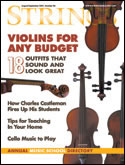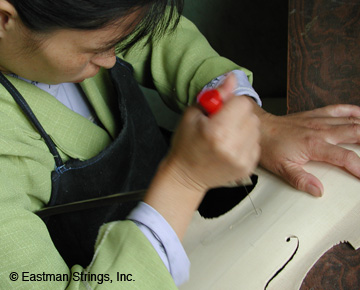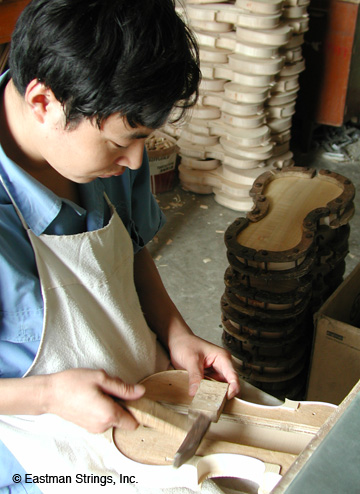|
In 1992 Qian Ni, who had come to the
United States from China to study music, founded Eastman Strings.
His company began buying string instruments from European-trained
Luthiers in his hometown in China. But before long, he
and his colleagues saw that a better system
was needed. This turned out to be an approach following
the pattern used so successfully in Europe a century before.
Mr. Ni hired Master
violin-makers, and with their help, built a
large violin workshop
devoted to the handcrafting of
string instruments. It was one of the first such workshops
the world had seen since the first half
of the 20th century. The workshop relies on skilled hands
and sharp tools, not on electric carving and milling machines.
At the head of the workshop is the small
group of Master Luthiers. These are violin makers
trained in the European methods of stringed
instrument making. Each of these Masters is a highly
experienced and talented violinmaker known for
producing very fine string instruments
. Each is in charge of the
production of a specific model of instrument. The
Master violin maker trains and supervises the carvers, selects the
wood, and oversees each step in the process of hand-crafting.
The carvers who
assist the Master Luthier are selected from among applicants with experience in handicraft and
the use of hand tools. But when they are hired,
they are not yet trained violin makers. They
are selected only after tests of their manual skills. The
Master then trains them in specific violin making
procedures. This means that each carver is not a fully-trained
violin maker, but more of an assistant to the Master.
Jobs in the Eastman Strings workshop are
very popular. The pay is high, the work is interesting
and requires great skill. Most importantly,
the workers learn a valuable trade
, resulting in steady employment. Craftspeople in the Eastman workshop
are members of Chinaís growing middle class. Now
that the Eastman Strings workshop is about 12 years old,
violin making is becoming a family trade for some families.
In the few years since this workshop was
created, the reputation of Eastman Strings for the
tonal quality and craftsmanship of their instruments has
become a worldwide standard
.
Almost as important as the skills of the
craftspeople, are the materials they
use to make Prodigy string instruments.
These highly skilled carvers go to great
lengths to ensure quality at every stage. See the step-by-step
process Prodigy uses to build a beautiful, and beautiful
sounding string instrument.
How can an instrument crafted in China be
as good as a European instrument? Performers and teachers
agree, Prodigy instruments have more in
common with a traditional European instrument than most of
those made in Europe today
.
Delve deeper into the story of Prodigy Instruments and founder Robert Kurzís
mission to bring affordable high quality string instruments to
student musicians.
How much will I love my Prodigy
instrument?Ask those who
already have played one, and recommend Prodigy to their
students.
|





